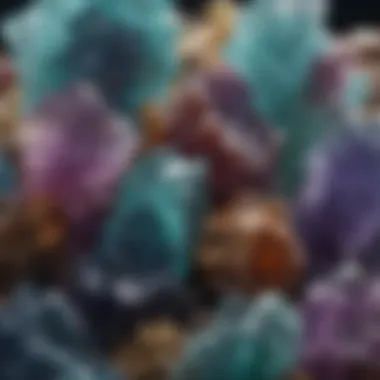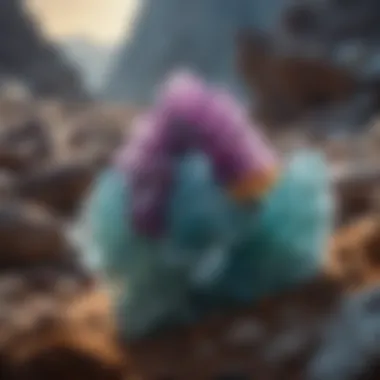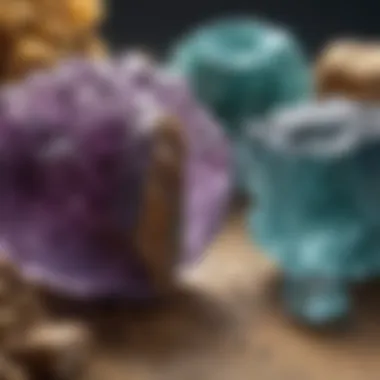Exploring Fluorite: Properties and Significance


Intro
Fluorite is a fascinating mineral, often recognized for its striking colors and attractive crystalline structure. While its visual appeal captures the attention of many, its significance stretches far beyond aesthetics. In this exploration, we will examine the properties that make fluorite unique, its various uses, and its relevance in the realm of mineral collecting. This knowledge is essential for both seasoned collectors and those new to the field, offering insights on how to acquire and care for these remarkable specimens.
Rock and Fossil Identification
When delving into the world of geology and mineral collecting, identifying the specific characteristics of rocks and fossils is crucial. For fluorite, there are several factors to consider.
Types of Fluorite
Fluorite comes in various colors and formations, with the most common types including:
- Purple Fluorite: Known for its deep violet hues, often found in cubic formations.
- Green Fluorite: A lighter variant, sometimes displaying banding patterns.
- Blue Fluorite: Rare and often highly sought after, typically formed in translucent cubes.
- Yellow Fluorite: Less common, with a bright, sunny appearance.
Characteristics to Look For
Understanding the traits of fluorite is vital for identification. Here are some key characteristics:
- Transparency: Fluorite can range from translucent to fully transparent.
- Crystal Structure: It primarily forms in cubic crystals, a distinctive feature that aids in recognition.
- Fluorescence: Under ultraviolet light, fluorite often displays a dramatic fluorescence, typically in shades of green.
Tools for Identification
Utilizing appropriate tools can make a significant difference in identifying fluorite accurately. Consider these options:
- Loupe or Microscope: Essential for examining crystal structures and surface details.
- UV Light: Useful for testing fluorescence.
- Hardness Test Kit: Since fluorite has a hardness of 4 on the Mohs scale, a simple scratch test can help in identification.
Collecting Tips and Techniques
Collecting fluorite can be rewarding, but it requires careful planning and execution. Here are some strategies to ensure a successful gathering experience:
Best Practices for Collecting
- Respect Nature: Always adhere to local regulations when collecting specimens.
- Be Prepared: Equip yourself with the necessary tools and safety gear.
- Document Locations: Taking notes can aid in returning to productive sites in the future.
Locating Prime Collecting Sites
Fluorite can be found in many locations worldwide. Notable sites include:
- Cave-in-Rock, Illinois: Known for vibrant purple and green fluorites.
- Spain: Famous for striking blue and yellow specimens.
- China: Offers unique crystallization patterns and colors.
How to Safely Extract Specimens
Proper extraction methods help preserve specimens while ensuring safety. Here are some tactics:
- Use Proper Tools: A rock hammer and chisel can help detach specimens without causing damage.
- Choose the Right Time: Collecting after rainfall can soften the soil and make extraction easier.
- Handle with Care: Use gloves and avoid applying excessive force during extraction to minimize breakage.
Preservation and Display
After acquiring fluorite specimens, appropriate preservation is necessary to maintain their beauty and integrity.
Techniques for Preserving Rocks and Fossils
- Cleaning: Gently wash with water and a soft brush, avoiding harsh chemicals that can damage the surface.
- Drying: Ensure specimens are completely dry before storage to prevent mold.
Proper Storage Methods
- Use Acid-Free Boxes: Store in boxes or containers that do not contain harmful chemicals.
- Avoid Direct Sunlight: Keep specimens in a dark place to prevent color fading.
Creative Display Ideas


Showcasing fluorite can enhance its appeal. Consider these display options:
- Shadow Boxes: Protect specimens while allowing visibility.
- Display Cases: Use glass cases to highlight unique crystallization and colors.
Geological Insights
Understanding the geological context of fluorite adds depth to its collection.
Geological Formations and Processes
Fluorite typically forms in a variety of geological environments, often linked to hydrothermal processes and sedimentary deposits. Learning about these processes can enhance appreciation for the mineral.
Historical Significance of Rocks and Fossils
Fluorite has historical relevance, particularly in its use in metallurgy and manufacturing. Collecting such minerals connects enthusiasts to significant historical narratives.
Notable Discoveries in the Field
Over the years, remarkable fluorite specimens have been discovered, capturing the interest of collectors and researchers alike. Some notable finds include the spectacular fluorite from the Illinois fluorite mines, known for their exceptional clarity and rich colors.
Fluorite is not just a colorful mineral; it tells a story of geological time, human ingenuity, and the passion of collectors.
By exploring these various facets of fluorite, collectors can gain a richer understanding of this captivating mineral.
Prelims to Fluorite
Fluorite is a mineral that captivates both enthusiasts and professionals alike. Its vibrant colors and unique formations make it a valuable specimen for collectors and a significant subject of study in geology. The significance of fluorite extends beyond its aesthetic appeal; it plays an essential role in various industries and has a rich historical relevance.
Understanding fluorite's properties, formation, and uses enhances our appreciation for this mineral. For collectors, it is crucial to grasp the unique characteristics that distinguish fluorite from other minerals. This knowledge allows collectors to make informed decisions when acquiring specimens, minimizing the risk of mistakes. Moreover, comprehending the mineral's industrial applications reveals its practical importance in fields like metallurgy and chemistry.
In this section, we will explore its definition and composition, providing a solid foundation for understanding fluorite's various aspects.
Geological Formation of Fluorite
The geological formation of fluorite is crucial to understanding its presence and significance in the natural world. This section investigates how fluorite originates within various geological environments, contributing to its widespread appeal in collecting and industrial applications. Knowledge of the formation processes allows enthusiasts to better appreciate the characteristics of their specimens, such as color and clarity, which are influenced by their origin.
Formation Processes
Fluorite forms through a variety of methods, predominately involving hydrothermal and sedimentary processes. Hydrothermal formation describes the emergence of fluorite from hot, mineral-rich waters circulating through rock. Conversely, sedimentary processes involve the precipitation of fluorite from evaporative minerals, mainly in marine settings. Understanding these processes enables collectors to identify the origins of different specimens, which can vary significantly in appearance depending on the conditions under which they formed.
Geological Settings
Hydrothermal
Hydrothermal settings are often where fluorite is found in significant quantities. In this context, fluorite crystallizes from solutions rich in calcium and fluoride. The temperature and pressure conditions in hydrothermal veins allow for large and well-formed crystals to develop. One key characteristic of hydrothermal fluorite is its transparency, often combined with vibrant colors that can include deep purple, green, or blue hues.
The popularity of hydrothermal fluorite among collectors is due to the striking visual appeal of these specimens. They tend to exhibit pronounced fluorescence, making them even more desirable. However, the extraction process can sometimes lead to fewer overall samples becoming available, making high-quality hydrothermal specimens particularly sought after and, therefore, pricier.
Metamorphic
Metamorphic processes also play a significant role in the formation of fluorite. In this environment, fluoride ions are introduced into pre-existing rocks, often under conditions of heat and pressure that alter the original material. This process results in fluorite occurring as a secondary mineral within metamorphic rocks. The key characteristic of metamorphic fluorite is its interaction with other minerals, creating unique composite specimens.
While metamorphic fluorite can be less visually striking than hydrothermal types, it possesses a certain rarity that can appeal to collectors looking for diverse specimens. However, the challenges faced in sourcing metamorphic fluorite make it less approachable for some enthusiasts.
Understanding the geological settings of fluorite not only aids in identifying its origins but also enhances the collectors' strategies for acquiring and appreciating this mineral. By recognizing the pathways through which fluorite forms, it becomes easier for collectors to assess the quality and characteristics of their specimens.
Physical Properties of Fluorite
Understanding the physical properties of Fluorite is essential for both collectors and professionals. These characteristics influence how the mineral is used across different industries and inform collectors about what to look for when acquiring specimens. Physical properties such as crystal structure, color variations, hardness, and cleavage not only define the mineral's unique attributes but also affect its aesthetic appeal and functional applications.
Crystal Structure


Fluorite has a distinctive cubic crystal system, which contributes to its striking visual qualities. The arrangement of atoms in its crystal lattice forms a stable and symmetrical shape, allowing for the formation of well-defined crystals. This crystal structure is responsible for the pursuit of high-quality specimens among collectors.
The symmetrical cube shape often exhibits faces that can be highly polished. This property makes Fluorite an attractive choice for display. Additionally, the crystal habit can vary depending on environmental conditions during its formation, adding to its allure. As such, understanding the crystal structure is fundamental when distinguishing Fluorite from similar minerals.
Color Variations
Fluorite is known for its diverse color range, which makes it a popular choice in mineral collection. Different colors are attributable to various impurities and structural defects within the crystal lattice.
Purple Fluorite
Purple Fluorite is especially sought after due to its vibrant hue. The key characteristic of this variant is its deep lavender color, which can range from light to dark tones. This striking appearance makes it a cherished selection among collectors. Its unique feature lies in the fluorescence which can appear under ultraviolet light, creating a captivating visual effect. However, this form can be sensitive to prolonged light exposure, which may lead to fading, marking a downside for those who wish to display it.
Green Fluorite
Green Fluorite often features a bright and lively green, resulting from the presence of iron. This variant is known for its clarity and is prized for both its beauty and perceived healing properties. It is a beneficial choice for collectors because it is one of the more common and accessible types. However, some green specimens may exhibit zoning, where varying shades appear, which can make selecting ideal pieces slightly challenging.
Blue Fluorite
Blue Fluorite is another appealing type, displaying a rich blue or cobalt hue. This variant is less common, thus elevating its desirability among collectors. Its unique feature is the soft, almost translucent quality that gives it a gentle appearance. It is favored for its rarity but can be more expensive and harder to find. Blue Fluorite also has a protective aura in metaphysical beliefs, further adding to its popularity.
Hardness and Cleavage
Fluorite is classified as a relatively soft mineral, with a hardness of 4 on the Mohs scale. This makes it easier to carve and shape, which is advantageous for artisans and jewelers. However, it also means that Fluorite specimens can be prone to scratches and damage if not properly handled. Collectors should be mindful of the impact this can have on the longevity and appearance of their pieces.
Moreover, the cleavage of Fluorite is another noteworthy characteristic. It exhibits perfect octahedral cleavage, allowing it to break along specific planes. Knowing this can guide collectors in how to care for their specimens, as improper handling can result in fractures.
Uses of Fluorite
Fluorite serves several practical and essential purposes across various industries and disciplines. Its unique properties make it a sought-after mineral not just for collectors, but also in commercial applications. Understanding the uses of fluorite helps to appreciate its relevance in both everyday life and specialized fields. This section explores industrial applications, optical uses, and its metaphysical properties.
Industrial Applications
Metallurgical Industry
Fluorite plays a fundamental role in the metallurgical industry. It functions primarily as a flux in the smelting process of metals like aluminum and copper. This means it reduces the melting point of ores and helps in removing impurities, ensuring a more efficient extraction of metals. The key characteristic of fluorite in this context is its ability to lower viscosity, allowing for easier handling and processing of molten materials.
Fluorite is a popular choice in this industry due to its effectiveness. Its unique feature lies in its ability to combine with other materials to form a slag that is easily removed. However, it is essential to consider environmental impacts. Fluorite mining can have ecological consequences which require careful management.
Chemical Production
In chemical production, fluorite is crucial in producing hydrofluoric acid, an important precursor for many fluorine-containing compounds. This aspect makes it vital for the manufacture of products like refrigerants and fluoropolymers. The significant characteristic of fluorite in this context is its fluorine content, which is essential for developing numerous materials.
Fluorite's unique feature in chemical production is its purity; high-quality fluorite is needed for the synthesis of specific chemicals. However, while it is a beneficial resource, there can be limitations. For instance, sourcing and transporting fluorite can present challenges, especially if quality and purity are to be maintained.
Optical Uses
Fluoride Glass
Fluoride glass is one of the notable applications of fluorite. This type of glass is utilized in specialized optical systems due to its unique properties. The main advantage of fluoride glass is its low dispersion and high transmission of infrared light. This quality is especially important in the production of high-end lenses and other optical components.
The unique feature of fluoride glass is its capability to maintain clarity over a wide range of wavelengths. This makes it ideal for applications like telescopes and laser systems. However, the production of fluoride glass can be more expensive than traditional glass, especially when considering factors like sourcing high-quality fluorite.
Spectroscopy
Spectroscopy benefits enormously from fluorite's properties. It is used as a material for lenses and prisms in various spectroscopic instruments due to its optical clarity and low scattering. This is a significant aspect since accurate measurements depend on the quality of lenses used in these instruments. The primary reason fluorite is favored in spectroscopy is its ability to transmit light without distorting the spectrum.
Its unique feature in this field is the stable and consistent refractive index across visible and ultraviolet regions, which enhances the performance of spectroscopic devices. However, there are disadvantages in terms of cost and careful handling, as fluorite can be more brittle compared to other optical materials.
Metaphysical Properties


Fluorite is often associated with various metaphysical properties by collectors and enthusiasts. Many believe it promotes clarity and focus, making it a popular choice for those pursuing mindfulness and meditation practices. Additionally, different colors of fluorite are thought to carry unique energies. For instance, green fluorite is often linked with healing, while purple fluorite is associated with spiritual growth.
While its metaphysical properties may not be scientifically substantiated, they add an enticing layer to its appeal in the mineral collecting community. Enthusiasts may incorporate fluorite into their practices both for its aesthetic qualities and the believed benefits it provides.
Fluorite in Collecting
Fluorite holds a prominent position in the realm of mineral collecting. Its diverse color palette and unique crystal formations make it visually appealing to collectors. Beyond aesthetic value, fluorite also has historical significance and practical applications. Understanding the nuances of collecting this mineral can enhance both enjoyment and value of a collection. Collectors can benefit from knowing where to obtain specimens, how to care for them, and the unique aspects that make fluorite desirable.
Acquisition of Specimens
Where to Find
Finding fluorite specimens can be an exciting endeavor for collectors. Many locations around the world are known for producing high-quality fluorite. Areas such as the Illinois Fluorspar District in the United States and the Hunan Province in China are particularly renowned. These sites are characterized by rich deposits of fluorite that have been mined for decades. Visiting these locations gives collectors the chance to discover specimens in their natural settings, adding authenticity to their collections.
The key characteristic of these mining sites is the availability of both rough and finished specimens. This variety allows collectors to choose between raw pieces, which are excellent for studying their geological origins, and polished specimens that are ready for display. This duality makes these locations a beneficial choice for anyone dedicated to fluorite collecting.
However, there are challenges involved. Mining sites can sometimes be difficult to access, requiring travel and potential physical exertion. Additionally, there is also a risk of collecting low-quality specimens if not enough research is done beforehand about the location.
Buying from Dealers
Purchasing fluorite from dealers is another viable option for collectors. Dealers often have extensive networks, allowing them to obtain rare specimens that might not be readily available. Buying from reputable dealers ensures that collectors receive genuine and high-quality fluorite. This route can save time and travel costs associated with field collecting.
One key characteristic of buying from dealers is the potential for acquiring specimens with documented provenance. This feature adds a layer of credibility and can enhance the collector's confidence about their purchases.
However, there are disadvantages. Prices can vary widely among dealers, and buyers should be cautious. It's essential to conduct thorough research on the dealer's reputation to avoid counterfeit or misrepresented specimens. Additionally, some collectors prefer the thrill of finding specimens themselves rather than relying on commercial sources.
Caring for Your Collection
Cleaning Techniques
Maintaining the beauty of fluorite specimens requires proper cleaning techniques. Dust, dirt, or other contaminants can mar the surface and impact the overall appearance. Using a soft brush and mild soap with lukewarm water is usually effective for routine cleaning. This method is gentle and allows the natural colors of the fluorite to shine through.
The advantage of this technique is its simplicity and effectiveness. It is also a popular choice among many collectors due to its low risk of damaging the specimen. However, careful attention must be paid to ensure that no harsh chemicals or abrasive materials are used, as these can cause irreparable harm to the stone.
Display Considerations
The way fluorite specimens are displayed can significantly affect their visual impact. Factors such as lighting, arrangement, and protective measures can enhance their presence in a collection. Many collectors opt for display cases that protect against dust and damage, while allowing light to pass through to highlight the crystal structures.
Using appropriate lighting can make colors appear more vibrant. It's beneficial to choose display options that allow flexibility in rearranging specimens as needed.
However, collectors must also consider potential environmental factors. Too much direct sunlight can lead to fading, while high humidity might affect the integrity of the specimens. Therefore, balance is key in creating a display that is both attractive and secure.
"The beauty of fluorite is not just in its colors, but in the stories it tells about the Earth’s history and the care taken by those who collect it."
In summary, collecting fluorite can be an enriching experience when done with the right knowledge and techniques. By understanding where to find or how to buy specimens, and knowing best practices for care and display, collectors can create a meaningful and visually stunning fluorite collection.
Ending
The importance of summarizing the significance of fluorite cannot be overstated. This mineral, known for its diverse applications and striking appearance, plays a vital role in both scientific research and the hobby of mineral collecting. Understanding fluorite's geological formation, physical properties, and varied uses allows collectors and enthusiasts to appreciate its value beyond just aesthetics.
Summation of Significance
Fluorite symbolizes a rich intersection of geology and practical applications. Its vibrant colors and unique crystal structures attract collectors. Moreover, it also serves crucial roles in industries such as metallurgy and chemical production.
Key aspects to consider include:
- Industrial Use: In addition to being favored by collectors, fluorite is essential for various industrial processes. Its derivatives are used in aluminum production and the creation of fluoride compounds.
- Research Value: For students and educators, fluorite offers a practical example of geological processes and crystal growth, making it invaluable in educational contexts.
- Metaphysical Aspects: Some collectors focus on the supposed metaphysical properties of fluorite, associating it with healing and spiritual growth, which adds another dimension to its significance.
The exploration of fluorite enriches our understanding of not just the mineral itself, but also the broader implications it has in various fields.
Future Trends in Fluorite Collection
As the world evolves, so does the field of mineral collecting. The trends for fluorite collection are also shifting:
- Sustainability and Ethical Sourcing: A growing trend among collectors is the emphasis on ethically sourced specimens. As awareness about environmental conservation rises, collectors are increasingly researching the origins of their pieces.
- Digital Community Engagement: With platforms like Reddit and Facebook, collectors are finding new ways to share their passion. Online groups and discussions nurture a sense of community and knowledge-sharing, attracting new enthusiasts.
- Technological Advances in Display: Collectors are also looking at innovative ways to showcase their fluorite specimens. This includes using custom lighting solutions and protective displays to highlight the mineral’s beauty effectively.
These trends demonstrate that the field of mineral collecting, particularly with fluorite, remains dynamic. As we look forward, embracing change while cherishing traditional practices will enhance the experience of collectors and enthusiasts alike.







